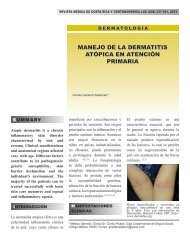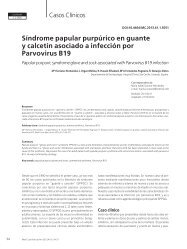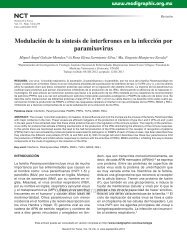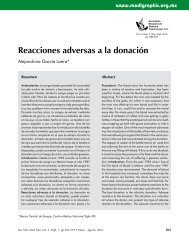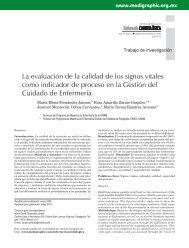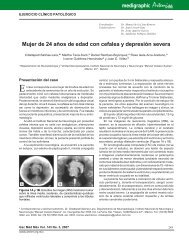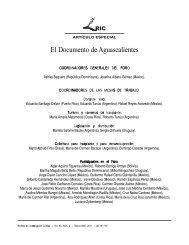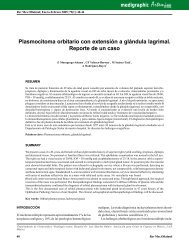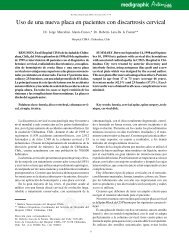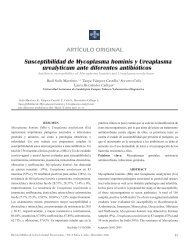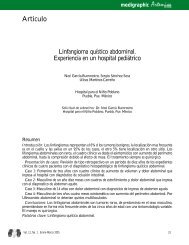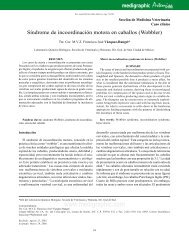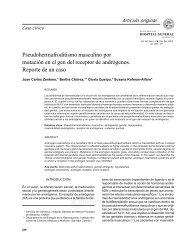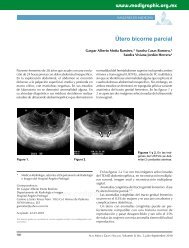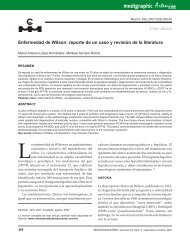Estudio de la respuesta inmune humoral y celular ... - edigraphic.com
Estudio de la respuesta inmune humoral y celular ... - edigraphic.com
Estudio de la respuesta inmune humoral y celular ... - edigraphic.com
Create successful ePaper yourself
Turn your PDF publications into a flip-book with our unique Google optimized e-Paper software.
Volumen<br />
Volume 34<br />
Artículo:<br />
Otras secciones <strong>de</strong><br />
este sitio:<br />
☞ Índice <strong>de</strong> este número<br />
☞ Más revistas<br />
☞ Búsqueda<br />
Veterinaria México<br />
Número<br />
Number 3<br />
Julio-Septiembre<br />
July-September 2003<br />
<strong>Estudio</strong> <strong>de</strong> <strong>la</strong> <strong>respuesta</strong> <strong>inmune</strong> <strong>humoral</strong><br />
y celu<strong>la</strong>r en <strong>la</strong> infección y reinfección<br />
experimental <strong>de</strong> bovinos con<br />
Anap<strong>la</strong>sma marginale<br />
Derechos reservados, Copyright © 2003:<br />
Facultad <strong>de</strong> Medicina Veterinaria y Zootecnia, UNAM<br />
Others sections in<br />
this web site:<br />
☞ Contents of this number<br />
☞ More journals<br />
☞ Search<br />
<strong>edigraphic</strong>.<strong>com</strong>
<strong>Estudio</strong> <strong>de</strong> <strong>la</strong> <strong>respuesta</strong> <strong>inmune</strong> <strong>humoral</strong> y celu<strong>la</strong>r en <strong>la</strong><br />
infección y reinfección experimental <strong>de</strong> bovinos con<br />
Anap<strong>la</strong>sma marginale<br />
Study of the <strong>humoral</strong> and cellu<strong>la</strong>r immune response in the<br />
experimental infection and reinfection of bovines with<br />
Anap<strong>la</strong>sma marginale<br />
Abstract<br />
The variations of peripheral blood T CD2+, CD4+, and CD8+ lymphocytes, IgG anti-Anap<strong>la</strong>sma antibodies<br />
(Abs) and interferon gamma (IFN-γ ) in sera and <strong>com</strong>plete blood culture (CBC) from bovines experimentally<br />
infected or not with the same Anap<strong>la</strong>sma marginale iso<strong>la</strong>te were evaluated. Seven 12 to 14 month old bovines<br />
were used. Four (Group I) were inocu<strong>la</strong>ted intravenously with 1 × 108 parasitized erythrocytes (PE)/animal,<br />
which contained the A. marginale Morelos iso<strong>la</strong>te, at day 0, and with 2 × 10 8 PE, at day 60; while the other three<br />
(Group C) were not infected. Peripheral blood samples and sera were collected from all animals to evaluate<br />
packed cell volume (PCV), percentage of parasitized erythrocytes (PEP), T CD2+, CD4+ and CD8+<br />
lymphocytes by cytofluorometry as well as Abs and IFN-γ by ELISA. In Group I, the maximum average PEP<br />
was 5.2% at day 31 postinfection (p.i.), while the PCV reached an average of 6% at day 46 p.i. Following<br />
reinfection (r.i.), the PEP was 0 and the PCV was normal. The values of CD2+ were simi<strong>la</strong>r in both groups<br />
during the study; however the CD4+ and CD8+ values in Group I dropped significantly (P < 0.05) at day 45<br />
p.i., <strong>la</strong>ter reaching simi<strong>la</strong>r values to those of Group C. A significant increase (P < 0.05) in fluorescence intensity<br />
(FI) in CD2+ and CD8+ lymphocytes from Group I r.i. (days 62 and 83), with respect to the FI obtained in<br />
lymphocytes from Group C, was observed. Abs levels in infected bovines increased above the basal values and<br />
those of the control animals, beginning at day 51 p.i. Simi<strong>la</strong>rly, IFN-γ levels in sera and CBC supernatant from<br />
infected bovines were significantly higher (P < 0.05), particu<strong>la</strong>rly after reinfection, than those from the noninfected<br />
animals.<br />
Key Key words: words: BOVINE BOVINE PERIPHERAL PERIPHERAL PERIPHERAL BLOOD BLOOD T T CD2+, CD2+, CD4+, CD4+, CD8+ CD8+ LYMPHOCYTES, LYMPHOCYTES, AAAAANAPLASMA<br />
NAPLASMA<br />
NAPLASMA<br />
NAPLASMA<br />
IgG IgG ANTIBODIES, ANTIBODIES, INTERFERON INTERFERON GAMMA.<br />
GAMMA.<br />
Resumen<br />
<strong>edigraphic</strong>.<strong>com</strong><br />
Carlos Ramón Bautista Garfias*<br />
Gustavo Pedraza Alva**<br />
Yvonne Rosenstein Azou<strong>la</strong>y**<br />
Javier Ontiveros Fernán<strong>de</strong>z***<br />
NAPLASMA MARGINALE,<br />
MARGINALE<br />
MARGINALE<br />
MARGINALE<br />
MARGINALE<br />
Se <strong>de</strong>terminaron <strong>la</strong>s fluctuaciones <strong>de</strong> linfocitos T CD2+, CD4+ y CD8+, anticuerpos IgG anti-Anap<strong>la</strong>sma (Acs)<br />
e interferon gamma (IFN-γ ) en el suero y en cultivo <strong>de</strong> sangre <strong>com</strong>pleta (CSC) <strong>de</strong> bovinos infectados con el<br />
Recibido el 2 <strong>de</strong> diciembre <strong>de</strong> 2002 y aceptado el 8 <strong>de</strong> abril <strong>de</strong> 2003.<br />
* Centro Nacional <strong>de</strong> Investigaciones Disciplinarias en Parasitología Veterinaria, Instituto Nacional <strong>de</strong> Investigaciones Forestales, Agríco<strong>la</strong>s<br />
y Pecuarias, Secretaría <strong>de</strong> Agricultura, Gana<strong>de</strong>ría, Desarrollo Rural, Pesca y Alimentación, km 15.5, Carretera Fe<strong>de</strong>ral Cuernavaca-Cuaut<strong>la</strong>,<br />
Jiutepec, 62550, Morelos, México.<br />
** Laboratorio <strong>de</strong> Inmunología, Instituto <strong>de</strong> Biotecnología, Universidad Nacional Autónoma <strong>de</strong> México, Chamilpa, Cuernavaca, Morelos,<br />
México.<br />
*** Centro Nacional <strong>de</strong> Servicios <strong>de</strong> Constatación en Salud Animal, Secretaría <strong>de</strong> Agricultura, Gana<strong>de</strong>ría, Desarrollo Rural, Pesca y<br />
Alimentación, km 15.5, Carretera Fe<strong>de</strong>ral Cuernavaca-Cuaut<strong>la</strong>, Jiutepec, 62550, Morelos, México.
mismo ais<strong>la</strong>do <strong>de</strong> Anap<strong>la</strong>sma marginale. Se utilizaron siete bovinos <strong>de</strong> 12 a 14 meses <strong>de</strong> edad. El día 0 fueron<br />
inocu<strong>la</strong>dos cuatro <strong>de</strong> ellos (grupo I) por vía intravenosa con 1 × 10 8 eritrocitos parasitados (EP), con el ais<strong>la</strong>do<br />
Morelos <strong>de</strong> A. marginale/animal, y con 2 × 10 8 EP el día 60; mientras que los otros tres bovinos (grupo T) no<br />
fueron infectados. Se colectaron muestras <strong>de</strong> sangre periférica y suero <strong>de</strong> todos los animales, para evaluar el<br />
volumen celu<strong>la</strong>r aglomerado (VCA), porcentaje <strong>de</strong> eritrocitos parasitados (PEP), linfocitos T CD2+, CD4+ y<br />
CD8+ por citofluorometría y Acs e IFN-γ por ELISA. En el grupo I, el PEP alcanzó un promedio máximo <strong>de</strong> 5.2%<br />
el día 31 posinfección (pi), mientras que el VCA disminuyó hasta un promedio <strong>de</strong> 6% el día 46 pi. En <strong>la</strong><br />
reinfección (ri), el PEP fue <strong>de</strong> 0 y el VCA fue normal. Los valores <strong>de</strong> CD2+ fueron simi<strong>la</strong>res en los dos grupos<br />
durante el estudio; en cambio, los <strong>de</strong> CD4+ y CD8+ en el grupo I disminuyeron significativamente (P < 0.05)<br />
en el día 45 pi, para <strong>de</strong>spués alcanzar valores simi<strong>la</strong>res a los <strong>de</strong>l grupo T. Se observó un aumento (P < 0.05) <strong>de</strong><br />
<strong>la</strong> intensidad <strong>de</strong> fluorescencia (IF) en los linfocitos CD2+ y CD8+ <strong>de</strong>l grupo I <strong>de</strong>spués <strong>de</strong> <strong>la</strong> ri (días 62 y 83) con<br />
respecto a <strong>la</strong> IF <strong>de</strong>terminada en los linfocitos <strong>de</strong>l grupo T. Los niveles <strong>de</strong> Acs <strong>de</strong> los bovinos infectados<br />
aumentaron por encima <strong>de</strong> los valores basales y <strong>de</strong> los <strong>de</strong> los animales testigo, a partir <strong>de</strong>l día 51 pi. Asimismo,<br />
los niveles <strong>de</strong> IFN-γ , tanto en el suero <strong>com</strong>o en el sobrenadante <strong>de</strong> CSC <strong>de</strong> los bovinos infectados, fueron<br />
significativamente más altos (P < 0.05) que los <strong>de</strong> los animales no infectados, particu<strong>la</strong>rmente en <strong>la</strong> ri.<br />
Pa<strong>la</strong>bras Pa<strong>la</strong>bras c<strong>la</strong>ve: c<strong>la</strong>ve: LINFOCITOS LINFOCITOS T T CD2+, CD2+, CD2+, CD4+ CD4+ Y Y CD8+ CD8+ CD8+ DE DE SANGRE SANGRE PERIFÉRICA PERIFÉRICA DE DE DE BOVINO, BOVINO, AAAAANAPLASMA<br />
NAPLASMA<br />
NAPLASMA<br />
NAPLASMA<br />
NAPLASMA<br />
MARGINALE, MARGINALE<br />
MARGINALE<br />
MARGINALE<br />
MARGINALE , ANTICUERPOS ANTICUERPOS IgG, IgG, INTERFERON INTERFERON GAMMA.<br />
GAMMA.<br />
Introduction<br />
ovine anap<strong>la</strong>smosis, a disease characterized<br />
by severe anemia, abortion and high mortality,<br />
is caused by the intraerithrocytic rickettsia<br />
Anap<strong>la</strong>sma marginale that is biologically transmitted<br />
by ticks of the Ixodidae family and mechanically<br />
transmitted by hematophagous diptera of the Tabanidae<br />
family. 1 Although A. marginale infection generates<br />
a <strong>humoral</strong> immune response, 2,3 the transfer of<br />
antibodies from sera or colostrum to susceptible<br />
animals does not confer protection. 3-5 Animals infected<br />
for the first time with virulent A. marginale strains<br />
<strong>de</strong>velop a strong cellu<strong>la</strong>r immune response that<br />
corresponds to the <strong>de</strong>velopment of clinical signs.<br />
Once the animal recovers from the acute infection<br />
phase it holds a solid cellu<strong>la</strong>r immune response and<br />
remains clinically protected and immune against<br />
reinfection, although the animal frequently be<strong>com</strong>es<br />
a subclinically infected carrier. 6 Cru<strong>de</strong> antigens<br />
from the rickettsia have been used to evaluate the<br />
cellu<strong>la</strong>r immune response in cattle. 7-9<br />
The protective role of the cellu<strong>la</strong>r immune response<br />
has been <strong>de</strong>monstrated in other intracellu<strong>la</strong>r infections<br />
such as those produced by Cowdria ruminantium,<br />
10-12 Rickettsia tsutsugamushi, 13,14 Ehrlichia risticii, 15,16<br />
Theileria parva, 17 P<strong>la</strong>smodium spp18 and other parasitic<br />
protozoa. 19 Not only are the macrophages important<br />
in the protection against intracellu<strong>la</strong>r pathogens 20-22<br />
but NK cells and T helper lymphocytes (Th) are too.<br />
The <strong>la</strong>tter are so important that the use of Th1 lymphocyte<br />
clones has been proposed to help i<strong>de</strong>ntify<br />
and characterize protective antigens and immune<br />
responses. 23,24<br />
248<br />
248<br />
Introducción<br />
a anap<strong>la</strong>mosis bovina, enfermedad caracterizada<br />
por anemia severa, abortos y alta mortalidad, es<br />
causada por <strong>la</strong> rickettsia intraeritrocítica Anap<strong>la</strong>sma<br />
marginale que es transmitida biológicamente por garrapatas<br />
<strong>de</strong> <strong>la</strong> familia Ixodidae y mecánicamente por dípteros<br />
hematófagos <strong>de</strong> <strong>la</strong> familia Tabanidae. 1 Aunque <strong>la</strong> infección<br />
por A. marginale genera una <strong>respuesta</strong> <strong>inmune</strong> <strong>humoral</strong>, 2,3<br />
<strong>la</strong> transferencia <strong>de</strong> anticuerpos <strong>de</strong>l suero o <strong>de</strong>l calostro a<br />
animales susceptibles no confiere protección. 3-5 Los animales<br />
que se infectan por primera vez con cepas virulentas <strong>de</strong><br />
A. marginale <strong>de</strong>sarrol<strong>la</strong>n una <strong>respuesta</strong> <strong>inmune</strong> celu<strong>la</strong>r<br />
sólida que correspon<strong>de</strong> al <strong>de</strong>sarrollo <strong>de</strong> signos clínicos; una<br />
vez que el animal se recupera <strong>de</strong> <strong>la</strong> fase aguda <strong>de</strong> <strong>la</strong><br />
infección mantiene una inmunidad celu<strong>la</strong>r vigorosa y<br />
permanece clínicamente protegido e <strong>inmune</strong> contra <strong>la</strong><br />
reinfección, aunque con frecuencia el animal se transforma<br />
en un portador subclínicamente infectado. 6 Para evaluar <strong>la</strong><br />
<strong>respuesta</strong> <strong>inmune</strong> celu<strong>la</strong>r en anap<strong>la</strong>smosis bovina se han<br />
utilizado antígenos crudos <strong>de</strong> <strong>la</strong> rickettsia. 7-9<br />
Se ha <strong>de</strong>mostrado el papel protector <strong>de</strong> <strong>la</strong> inmunidad<br />
celu<strong>la</strong>r en otras infecciones intracelu<strong>la</strong>res, <strong>com</strong>o <strong>la</strong>s inducidas<br />
por Cowdria ruminantium, 10-12 Rickettsia tsutsugamushi,<br />
13,14 Ehrlichia risticii, 15,16 Theileria parva, 17 P<strong>la</strong>smodium spp18 y otros protozoarios parásitos. 19 No so<strong>la</strong>mente los macrófagos<br />
<strong>de</strong>sempeñan un papel importante en <strong>la</strong> protección<br />
contra patógenos intracelu<strong>la</strong>res20-22 sino también <strong>la</strong>s célu-<br />
<strong>edigraphic</strong>.<strong>com</strong><br />
<strong>la</strong>s NK y los linfocitos T cooperadores (Th). Tan importan-<br />
tes son los últimos que se ha propuesto utilizar clones <strong>de</strong><br />
linfocitos Th1 <strong>com</strong>o sondas para i<strong>de</strong>ntificar y caracterizar<br />
antígenos protectores y <strong>respuesta</strong>s <strong>inmune</strong>s. 23,24<br />
Con base en lo anterior, es necesario conocer los<br />
mecanismos inmunitarios protectores que operan en
Based on the previous information, it is necessary<br />
to know the protective immune mechanisms that<br />
operate in cattle against Anap<strong>la</strong>sma marginale before<br />
establishing effective immunoprophy<strong>la</strong>ctic control<br />
measures. In this context and with the objective of<br />
contributing to such knowledge, the current study<br />
presents data concerning the changes of peripheral T<br />
CD2, CD4 and CD8 lymphocytes (numbers and fluorescence<br />
intensity), IgG anti-Anap<strong>la</strong>sma antibodies and<br />
of interferon gamma (IFN-γ ) in sera, as well as the<br />
production of this cytokine in response to a rickettsia<br />
antigen in in vitro <strong>com</strong>plete blood cultures from cattle<br />
infected and reinfected with the same A. marginale<br />
iso<strong>la</strong>te.<br />
Material and methods<br />
Anap<strong>la</strong>sma marginale iso<strong>la</strong>te<br />
The mexican Anap<strong>la</strong>sma marginale iso<strong>la</strong>te used in the<br />
study was obtained from infected cattle from the<br />
state of Morelos (MEX-17-029-01) and was kept in a<br />
stable state. The infected erythrocytes were suspen<strong>de</strong>d<br />
in a 1:1 31.2% (w/v) mixture of dimethylsulfoxi<strong>de</strong>-phosphate<br />
buffered solution (PBS) pH 7.2<br />
and then they were frozen in liquid nitrogen 25 until<br />
further use.<br />
Experimental animals<br />
Seven Swiss × Holstein 12- to 14-month-old cattle<br />
crosses, from the state of Coahui<strong>la</strong>, :rop :rop odarobale odarobale Mexico, were FDP<br />
FDP<br />
used. Animals were free of tuberculosis as <strong>de</strong>termined<br />
by the tuberculin VC VC ed ed AS, AS, ci<strong>de</strong>mihparG<br />
ci<strong>de</strong>mihparG<br />
test; of brucellosis, by<br />
serological tests; of babesiosis, by indirect immunofluorescence;<br />
and of anap<strong>la</strong>smosis, arap<br />
arapby<br />
ELISA.<br />
Likewise, blood smears stained with Giemsa were<br />
analyzed acidémoiB acidémoiB acidémoiB to corroborate arutaretiL arutaretiL the :cihpargi<strong>de</strong>M<br />
:cihpargi<strong>de</strong>M<br />
:cihpargi<strong>de</strong>M<br />
absence of hemopara-<br />
sustraído<strong>de</strong>-m.e.d.i.g.r.a.p.h.i.c<br />
sites. sustraído<strong>de</strong>-m.e.d.i.g.r.a.p.h.i.c<br />
Animals were allocated in pens with a concrete<br />
floor, where they were fed with hay and<br />
<strong>com</strong>mercial food, and had drinking water ad libitum.<br />
After the experimental A. marginale infection<br />
of animals, parasitemia data were collected every<br />
other day. Each bovine in the infected group (I)<br />
was inocu<strong>la</strong>ted with 1 × 108 Anap<strong>la</strong>sma marginale<br />
(MEX-17-029-01 iso<strong>la</strong>te) parasitized erythrocytes;<br />
while the other three animals were not infected<br />
and served as a control (C). Blood peripheral T<br />
lymphocytes, percentage of parasitized erythrocytes<br />
(PPE), packed cell volume (% PCV) and temperature<br />
were <strong>de</strong>termined in the same animals at<br />
days 0, 8, 15, 23, 31, 37, 46, 51, 72, 82, 89, 96 and 98.<br />
The infected bovines were reinfected at day 60<br />
with 2 × 108 Anap<strong>la</strong>sma marginale (MEX-17-029-01<br />
iso<strong>la</strong>te) per bovine.<br />
los bovinos contra Anap<strong>la</strong>sma marginale antes <strong>de</strong> establecer<br />
medidas eficaces <strong>de</strong> control inmunoprofiláctico.<br />
En este contexto y con el objeto <strong>de</strong> contribuir a dicho<br />
conocimiento, en el presente estudio se presenta información<br />
sobre los cambios <strong>de</strong> linfocitos T CD2, CD4 y<br />
CD8 <strong>de</strong> sangre periférica (cantidad e intensidad <strong>de</strong><br />
fluorescencia), <strong>de</strong> anticuerpos IgG anti-Anap<strong>la</strong>sma y <strong>de</strong><br />
interferon gamma (IFN-γ ) en el suero, así <strong>com</strong>o <strong>de</strong> <strong>la</strong><br />
producción <strong>de</strong> esta citocina en <strong>respuesta</strong> a un antígeno<br />
<strong>de</strong> <strong>la</strong> rickettsia en cultivos in vitro <strong>de</strong> sangre <strong>com</strong>pleta <strong>de</strong><br />
bovinos infectados y reinfectados con el mismo ais<strong>la</strong>do<br />
<strong>de</strong> A. marginale.<br />
Material y métodos<br />
Ais<strong>la</strong>do <strong>de</strong> Anap<strong>la</strong>sma marginale<br />
El ais<strong>la</strong>do mexicano <strong>de</strong> Anap<strong>la</strong>sma marginale usado en<br />
el estudio fue colectado <strong>de</strong> ganado infectado en Morelos,<br />
México (MEX-17-029-01), y se mantuvo <strong>com</strong>o<br />
estabilizado. Los eritrocitos infectados fueron suspendidos<br />
1:1 en solución 31.2% (w/v) <strong>de</strong> dimetilsulfóxido<br />
en solución salina amortiguadora <strong>de</strong> fosfatos<br />
(SSAF), pH 7.2 y se almacenaron en nitrógeno líquido<br />
25 hasta su uso.<br />
Animales experimentales<br />
Se utilizaron siete bovinos cruza <strong>de</strong> Pardo Suizo ×<br />
Holstein, <strong>de</strong> 12 a 14 meses <strong>de</strong> edad, proce<strong>de</strong>ntes <strong>de</strong><br />
Coahui<strong>la</strong>, México. Se <strong>de</strong>terminó que los animales esta-<br />
sustraído<strong>de</strong>-m.e.d.i.g.r.a.p.h.i.c<br />
ban sustraído<strong>de</strong>-m.e.d.i.g.r.a.p.h.i.c<br />
sustraído<strong>de</strong>-m.e.d.i.g.r.a.p.h.i.c<br />
libres <strong>de</strong> tuberculosis por medio <strong>de</strong> <strong>la</strong> prueba <strong>de</strong><br />
tuberculina; <strong>de</strong> brucelosis por medio <strong>de</strong> pruebas sexológicas;<br />
<strong>de</strong> babesiosis, por medio <strong>de</strong> inmunofluorescencia<br />
indirecta, y <strong>de</strong> anap<strong>la</strong>smosis por medio <strong>de</strong> ELI-<br />
SA. Asimismo, se analizaron frotis <strong>de</strong> sangre teñidos<br />
con Giemsa, para confirmar <strong>la</strong> ausencia <strong>de</strong> hemoparásitos.<br />
Los animales se mantuvieron ais<strong>la</strong>dos en corrales<br />
con piso <strong>de</strong> concreto y consumieron alimento (alfalfa<br />
acica<strong>la</strong>da, paja <strong>de</strong> avena, alimento <strong>com</strong>ercial) y agua ad<br />
libitum. Después <strong>de</strong> <strong>la</strong> infección experimental <strong>de</strong> los<br />
animales con A. marginale, se recolectaron los datos <strong>de</strong><br />
parasitemia cada tercer día. Cada uno <strong>de</strong> los cuatro<br />
bovinos <strong>de</strong>l grupo infectado (I) fue inocu<strong>la</strong>do con 1 ×<br />
108 eritrocitos parasitados con Anap<strong>la</strong>sma marginale (ais<strong>la</strong>do<br />
MEX-17-029-01); mientras que los otros tres animales<br />
no fueron infectados y permanecieron <strong>com</strong>o<br />
grupo testigo (T). Los linfocitos T <strong>de</strong> sangre periférica,<br />
el porcentaje <strong>de</strong> eritrocitos parasitados (PEP), el porcentaje<br />
<strong>de</strong>l volumen celu<strong>la</strong>r aglomerado (%VCA) y <strong>la</strong><br />
temperatura fueron evaluados en todos los animales<br />
los días 0, 8, 15, 23, 31, 37, 46, 51, 72, 82, 89, 96 y 98. Los<br />
cuatro bovinos infectados fueron reinfectados el día 60<br />
con 2 × 108 eritrocitos parasitados con A. marginale<br />
(ais<strong>la</strong>do MEX-17-029-01)/bovino.<br />
<strong>edigraphic</strong>.<strong>com</strong><br />
MG MG MG MG MG VV<br />
Vet. VV<br />
MM<br />
Méx., MM<br />
34 (3) 2003 249<br />
249
Percentage of parasitized erythrocytes<br />
(PPE), packed cell volume (% PCV) and<br />
temperature<br />
The blood collected from animals was used to prepare<br />
blood smears which were stained with Giemsa to <strong>de</strong>termine<br />
the PPE by light microscopy 26 and to evaluate<br />
the PCV (recor<strong>de</strong>d as a percentage) by standard methods.<br />
27 Body temperature (in °C) was assessed using a<br />
standard thermometer.<br />
Peripheral blood T cells<br />
Peripheral blood lymphocytes in blood samples were<br />
characterized by cytofluorometry (CF) at days 0, 8, 15,<br />
23, 31, 37, 46, 51, 72, 82, 89, 96 and 98, using mouse anti-<br />
CD2 + , anti-CD4 + and anti-CD8 + monoclonal antibodies<br />
(mAb) (Serotec, Eng<strong>la</strong>nd) as <strong>de</strong>scribed by Bautista<br />
et al. 28 To 100 µl of blood collected in tubes containing<br />
EDTA, 10 µl (diluted 1:100 in PBS) of anti-CD2+,<br />
CD4+ or anti-CD8+ mAb were ad<strong>de</strong>d; this mixture<br />
was incubated for 30 min at 4°C in darkness, after<br />
which, 20 µl of goat anti-mouse immune globulin<br />
serum (diluted 1:100 in PBS), conjugated with fluorescein<br />
isotyocianate,* were ad<strong>de</strong>d; the mixture was<br />
incubated again for 30 min at 4 o C in darkness. Next, 2<br />
ml of lysis solution** were ad<strong>de</strong>d and the mixture<br />
was incubated during 15 min at room temperature.<br />
Later the sample was centrifuged at 380 g for 5 min at<br />
4 o C, and the sediment obtained was resuspen<strong>de</strong>d in 2<br />
ml of PBS and centrifuged at 380 g for 5 min at 4 o C;<br />
finally, the supernatant was discar<strong>de</strong>d and 0.5 ml of a<br />
0.5% paraformal<strong>de</strong>hy<strong>de</strong> solution was ad<strong>de</strong>d; the sample<br />
was kept at 4 o C in the darkness for no longer than<br />
one week. Readings were carried out in a FACScan<br />
cytometer.*** The data, recor<strong>de</strong>d as percentages, were<br />
analyzed with CellQuest software. † The fluorescence<br />
intensity in the analyzed samples was <strong>de</strong>termined<br />
and registered.<br />
Peripheral blood T cells/mm 3<br />
The quantity of CD2 + , CD4 + and CD8 + lymphocytes<br />
per mm 3 of peripheral blood in the cattle was <strong>de</strong>termined<br />
according to Bautista et al., 28 based upon the<br />
peripheral blood leukocyte differential count.<br />
A. marginale purification<br />
The A. marginale initial bodies were obtained from<br />
bovine erythrocytes parasitized with the A. marginale<br />
MEX-31-096-01 iso<strong>la</strong>te according to the method<br />
<strong>de</strong>scribed by Palmer and McGuire. 29 The parasitized<br />
erythrocytes (4 x 109 ) were rinsed three times<br />
by centrifugation at 27 000 g. Before each rinse, the<br />
250<br />
250<br />
Porcentaje <strong>de</strong> eritrocitos parasitados<br />
(PEP), volumen celu<strong>la</strong>r aglomerado (VCA)<br />
y temperatura<br />
Las muestras sanguíneas colectadas <strong>de</strong> los animales se<br />
utilizaron para <strong>la</strong> preparación <strong>de</strong> extendidos sanguíneos;<br />
con el fin <strong>de</strong> <strong>de</strong>terminar el PEP por medio <strong>de</strong><br />
microscopia <strong>de</strong> luz, se tiñeron con colorante <strong>de</strong> giemsa<br />
26 y para <strong>la</strong> <strong>de</strong>terminación <strong>de</strong>l VCA (registrado <strong>com</strong>o<br />
porcentaje) por medio <strong>de</strong> métodos estándar. 27 La temperatura<br />
(en °C) se midió con un termómetro rectal<br />
estándar.<br />
Célu<strong>la</strong>s T <strong>de</strong> sangre periférica<br />
Los linfocitos <strong>de</strong> sangre periférica en <strong>la</strong>s muestras sanguíneas<br />
fueron caracterizados por citometría <strong>de</strong> flujo (CF) los<br />
días 0, 8, 15, 23, 31, 37, 46, 51, 72, 82, 89, 96 y 98, usando<br />
anticuerpos monoclonales (AcM) <strong>de</strong> ratón anti-CD2 + ,<br />
anti-CD4 + y anti-CD8 + (Serotec, Ing<strong>la</strong>terra) <strong>de</strong> acuerdo<br />
con Bautista et al., 28 a 100 µl <strong>de</strong> sangre colectada en tubos<br />
que contenían EDTA, se le añadieron 10 µl (diluida 1:100<br />
en solución salina amortiguadora <strong>de</strong> fosfatos, SSAF) <strong>de</strong><br />
AcM anti-CD2 + , CD4 + o anti-CD8 + ; esta mezc<strong>la</strong> se incubó<br />
durante 30 min a 4 o C en <strong>la</strong> oscuridad; luego se adicionaron<br />
20 µl <strong>de</strong> suero <strong>de</strong> cabra anti-inmunoglobulinas <strong>de</strong><br />
ratón (diluido 1:100 en SSAF), conjugado con isotiocianato<br />
<strong>de</strong> fluoresceína,* <strong>la</strong> mezc<strong>la</strong> se incubó nuevamente<br />
durante 30 min a 4 o C en <strong>la</strong> oscuridad. A continuación se<br />
añadieron dos ml <strong>de</strong> solución <strong>de</strong> lisis** y esta mezc<strong>la</strong> fue<br />
incubada durante 15 min a temperatura ambiente. Posteriormente<br />
<strong>la</strong> muestra se centrifugó a 380 g durante 5 min<br />
a 4 o C, y el sedimento obtenido fue resuspendido con 2 ml<br />
<strong>de</strong> SSAF y centrifugado a 380 g durante 5 min a 4 o C;<br />
finalmente, el sobrenadante se <strong>de</strong>cantó para luego adicionar<br />
0.5 ml <strong>de</strong> una solución <strong>de</strong> paraformal<strong>de</strong>hído al 0.5%;<br />
<strong>la</strong> muestra se mantuvo a 4 o C en <strong>la</strong> oscuridad durante un<br />
<strong>la</strong>pso no mayor <strong>de</strong> una semana. La CF se llevó a cabo con<br />
un citómetro FACScan.*** Los datos, registrados <strong>com</strong>o<br />
porcentajes se analizaron con el programa CellQuest. †<br />
Asimismo, se <strong>de</strong>terminó y registró <strong>com</strong>o porcentaje <strong>la</strong><br />
intensidad <strong>de</strong> fluorescencia en <strong>la</strong>s muestras analizadas.<br />
Célu<strong>la</strong>s T/mm 3 <strong>de</strong> sangre periférica<br />
La cantidad <strong>de</strong> linfocitos CD2 + , CD4 + y CD8 + por mm3 <strong>de</strong> sangre periférica en los bovinos se <strong>de</strong>terminó <strong>de</strong><br />
acuerdo con Bautista et al., 28 con base en el conteo<br />
diferencial <strong>de</strong> leucocitos <strong>de</strong> sangre periférica.<br />
<strong>edigraphic</strong>.<strong>com</strong><br />
* Sigma, Missouri, USA.<br />
** Becton Dickinson, San Jose, CA, USA.<br />
*** Becton Dickinson, San Jose, CA, USA.<br />
† Becton-Dickinson, San Jose, CA, USA.
sediment from the previous centrifugation was suspen<strong>de</strong>d<br />
in 40 ml of RPMI 1640 with 2 mM L-<br />
Glutamine and 25 mM HEPES. The sediment of the<br />
final centrifugation was suspen<strong>de</strong>d in 35 ml of<br />
culture medium, and then sonicated at 50 W for 2<br />
min, and washed by suspension and centrifugation<br />
twice at 1 650 g for 15 min. The quantity of protein<br />
in the preparations was <strong>de</strong>termined in accordance<br />
with Lowry et al. 30<br />
Detection of IgG anti-Anap<strong>la</strong>sma marginale<br />
antibodies by ELISA<br />
Serum samples were obtained before infection with<br />
A. marginale, and during days 8, 15, 23, 31, 37, 46, 51,<br />
72, 82, 89, 96 and 98. IgG anti-A. marginale levels were<br />
<strong>de</strong>termined by ELISA using A. marginale organisms<br />
as the antigen. These were washed with sodium<br />
do<strong>de</strong>cyl sulfate (SDS), then they were exposed to the<br />
bovine serum according to Winkler et al. 31 and <strong>la</strong>ter<br />
exposed to rabbit serum anti-bovine IgG conjugated<br />
with alkaline phosphatase* in p-nitrophenyl phosphate,<br />
disodium** as a substrate. After an additional<br />
washing, the readings were carried out in an ELISA<br />
rea<strong>de</strong>r*** at an optical <strong>de</strong>nsity (OD) of 405 nm. The<br />
sera, diluted 1:100, with optical <strong>de</strong>nsities greater<br />
than 0.200 (mean + two standard <strong>de</strong>viations of the<br />
results obtained with sera from A. marginale-free<br />
cattle) were consi<strong>de</strong>red positives to anti-A. marginale<br />
antibodies.<br />
Determination of interferon gamma (IFNγγγγγ<br />
) in serum and in supernatant from <strong>com</strong>plete<br />
blood culture, by ELISA<br />
The sera collected at days 0, 8, 15, 23, 31, 37, 46, 51,<br />
72, 82, 89, 96 and 98 were analyzed using a <strong>com</strong>mercial<br />
bovine IFN-γ ELISA kit. † Likewise, at days 0, 10,<br />
23, 92 and 98, <strong>com</strong>plete blood cultures from all<br />
animals were carried out (1 ml per animal/well in<br />
24-well f<strong>la</strong>t bottomed Falcon microp<strong>la</strong>tes) in the<br />
presence of 10 µg of A. marginale antigen/sample in<br />
a humidified incubator, with 5% CO at 37°C dur-<br />
2<br />
ing 24 h. Once the time had e<strong>la</strong>psed the supernatants<br />
were collected and examined by the <strong>com</strong>mercial<br />
bovine IFN-γ ELISA kit following the manufacturer’s<br />
instructions. The readings were carried out<br />
in an ELISA rea<strong>de</strong>r ‡ at an optical <strong>de</strong>nsity (OD) of<br />
650 nm.<br />
Statistical analysis<br />
The <strong>com</strong>parison of data between groups was carried<br />
out by ANOVA. 32 Values of P < 0.05 were consi<strong>de</strong>red<br />
significant.<br />
Purificación <strong>de</strong> A. marginale<br />
Los cuerpos iniciales <strong>de</strong> A. marginale se obtuvieron a partir<br />
<strong>de</strong> eritrocitos <strong>de</strong> bovino parasitados con el ais<strong>la</strong>do MEX-<br />
31-096-01 <strong>de</strong> A. marginale <strong>de</strong> acuerdo con el método<br />
<strong>de</strong>scrito por Palmer y McGuire. 29 Los eritrocitos parasitados<br />
(4 × 10 9 ) se <strong>la</strong>varon tres veces por centrifugación a<br />
27 000 g. Antes <strong>de</strong> cada <strong>la</strong>vado, el sedimento <strong>de</strong> <strong>la</strong> centrifugación<br />
previa fue resuspendido en 40 ml <strong>de</strong> medio<br />
RPMI 1640 con 2 mM L-Glutamina y 25 mM HEPES. El<br />
sedimento <strong>de</strong> <strong>la</strong> centrifugación final fue resuspendido en<br />
35 ml <strong>de</strong> medio, sometido a sonicación a 50 W durante 2<br />
min y <strong>la</strong>vado por centrifugación dos veces a 1 650 g<br />
durante 15 min. La cantidad <strong>de</strong> proteína en <strong>la</strong>s preparaciones<br />
se <strong>de</strong>terminó <strong>de</strong> acuerdo con Lowry et al. 30<br />
Detección <strong>de</strong> anticuerpos IgG anti-Anap<strong>la</strong>sma<br />
marginale por medio <strong>de</strong> ELISA<br />
Se obtuvieron muestras <strong>de</strong> suero antes <strong>de</strong> <strong>la</strong> infección<br />
con A. marginale, y durante los días 8, 15, 23, 31, 37, 46, 51,<br />
72, 82, 89, 96 y 98. Los niveles <strong>de</strong> IgG anti-A. marginale se<br />
<strong>de</strong>terminaron por ELISA usando A. marginale <strong>com</strong>o<br />
antígeno; dichos organismos se <strong>la</strong>varon con do<strong>de</strong>cil<br />
sulfato <strong>de</strong> sodio (SDS), se expusieron al suero <strong>de</strong> bovino<br />
<strong>de</strong> acuerdo con Winkler et al. 31 y <strong>de</strong>spués fueron expuestos<br />
a suero <strong>de</strong> conejo anti IgG <strong>de</strong> bovino conjugado con<br />
fosfatasa alcalina* en p-Nitrophenyl Phosphate, Disodium**<br />
<strong>com</strong>o sustrato. Se hizo un <strong>la</strong>vado adicional y <strong>la</strong>s<br />
lecturas se llevaron a cabo en con lector <strong>de</strong> ELISA*** a<br />
una <strong>de</strong>nsidad óptica (DO) <strong>de</strong> 405 nm. Los sueros, diluidos<br />
1:100, con <strong>de</strong>nsida<strong>de</strong>s ópticas mayores a 0.200 (media<br />
+ dos <strong>de</strong>sviaciones estándar <strong>de</strong> los resultados obtenidos<br />
con sueros <strong>de</strong> bovinos libres <strong>de</strong> A. marginale) se<br />
consi<strong>de</strong>raron positivos a anticuerpos anti-A. marginale.<br />
Determinación <strong>de</strong> interferon gamma (IFNγγγγγ<br />
) en suero y en sobrenadante <strong>de</strong> cultivo<br />
<strong>de</strong> sangre <strong>com</strong>pleta por medio <strong>de</strong> ELISA<br />
Mediante un paquete <strong>com</strong>ercial <strong>de</strong> ELISA † se analizaron<br />
los sueros colectados los días 0, 8, 15, 23, 31, 37, 46,<br />
51, 72, 82, 89, 96 y 98. Asimismo, los días 0, 10, 23, 92 y<br />
98 se llevaron a cabo cultivos <strong>de</strong> sangre <strong>com</strong>pleta<br />
heparinizada <strong>de</strong> cada uno <strong>de</strong> los animales infectados y<br />
testigo (1 ml por animal/pozo en microp<strong>la</strong>cas <strong>de</strong> 24<br />
pozos <strong>de</strong> fondo p<strong>la</strong>no –Falcon–) en presencia <strong>de</strong> 10 µg<br />
<strong>de</strong> antígeno <strong>de</strong> A. marginale/muestra en estufa humidificada,<br />
con 5% <strong>de</strong> CO a 37°C durante 24 h. Transcurri-<br />
2<br />
<strong>edigraphic</strong>.<strong>com</strong><br />
* Sigma, Missouri, USA.<br />
** pNPP, Sigma, Missouri, USA.<br />
*** Multiskan Plus, Labsystems, Fin<strong>la</strong>nd.<br />
† IDEXX <strong>la</strong>boratories, Westbrook, Maine, USA.<br />
‡ Multiskan Plus, Labsystems, Fin<strong>la</strong>nd.<br />
MG MG MG MG MG VV<br />
Vet. VV<br />
MM<br />
Méx., MM<br />
34 (3) 2003 251<br />
251
Results<br />
In the infected group, the PPE reached a maximum<br />
average of 5.2% at day 31 posinfection (pi) that diminished<br />
to less than 1% at day 46, and <strong>la</strong>ter on the<br />
rickettsia was no longer <strong>de</strong>tected in blood smears even<br />
after reinfection (Figure 1a). The PCV diminished until<br />
it reached an average of 6% at day 46 pi and was within<br />
normal limits from reinfection up to the end of the<br />
study (Figure 1b). The CD2+ values were simi<strong>la</strong>r in<br />
both groups during the study; while those of CD4+<br />
and CD8+ in the infected group significantly diminished<br />
(P < 0.05) at day 44 pi and <strong>la</strong>ter reached values<br />
simi<strong>la</strong>r to those of the control group (Figure 2). A<br />
significant increase of fluorescence intensity (FI) in<br />
CD2+ and CD8+ lymphocytes from animals in the<br />
infected group after reinfection (days 62 and 83) (P <<br />
0.05) with respect to the FI observed in the lymphocytes<br />
from the control group was noticed (Figure 3).<br />
Antibody titers (Abs) in the infected cattle increased<br />
above the basal values at day 51 pi and increased even<br />
more after reinfection. In the Control group, antibody<br />
titers were within basal values (Figure 4a). The interferon<br />
gamma (IFN-γ ) levels in the sera from infected<br />
animals increased steadily, particu<strong>la</strong>rly following day<br />
51 pi, while levels in the Control group remained<br />
within basal limits (Figure 4b). In the supernatants of<br />
<strong>com</strong>plete blood cultures from infected animals, the<br />
IFN-γ levels were higher after reinfection than after the<br />
primary infection; while in the supernatants of blood<br />
from the control group those levels remained within<br />
the basal limits (Figure 5).<br />
Discussion<br />
It has been stressed that vaccination against anap<strong>la</strong>smosis<br />
has been an effective measure for outbreak prevention;<br />
however the existent vaccines, live or attenuated,<br />
<strong>de</strong>pend on bovine blood as a source of infection<br />
or of antigen. 33 Vaccines obtained from blood have the<br />
inconvenience of transmitting other bovine pathogens,<br />
that are imperceptible at the time of blood collection;<br />
besi<strong>de</strong>s, the different Anap<strong>la</strong>sma marginale geographical<br />
iso<strong>la</strong>tes frequently do not induce cross protection.<br />
33 In this context, and taking into account recent<br />
studies on the different genotypes, 34,35 and on A. marginale<br />
antigenic variation36 it is mandatory to better un<strong>de</strong>rstand<br />
the host immune mechanisms responsible<br />
for protection in bovine anap<strong>la</strong>smosis, and to i<strong>de</strong>ntify<br />
the rickettsial epitopes involved in the induction of<br />
both <strong>humoral</strong> and cellu<strong>la</strong>r immune responses 33 so as to<br />
<strong>de</strong>sign or establish effective immunoprophy<strong>la</strong>ctic control<br />
measures. With this in mind, the information generated<br />
by the present study contributes to the un<strong>de</strong>rstanding<br />
of these mechanisms.<br />
252<br />
252<br />
do ese tiempo se colectaron los sobrenadantes y se<br />
examinaron por medio <strong>de</strong>l paquete <strong>com</strong>ercial <strong>de</strong> ELI-<br />
SA, siguiendo <strong>la</strong>s indicaciones <strong>de</strong>l fabricante. Las lecturas<br />
se llevaron a cabo en un lector <strong>de</strong> ELISA ‡ a una<br />
<strong>de</strong>nsidad óptica (DO) <strong>de</strong> 650 nm.<br />
Análisis estadístico<br />
La <strong>com</strong>paración <strong>de</strong> datos entre grupos se llevó a cabo<br />
por medio <strong>de</strong> un análisis <strong>de</strong> varianza. 32 Valores <strong>de</strong> P <<br />
0.05 fueron consi<strong>de</strong>rados <strong>com</strong>o significativos.<br />
Resultados<br />
En el grupo infectado el PEP alcanzó un promedio<br />
máximo <strong>de</strong> 5.2% el día 31 posinfección (pi) para bajar<br />
a menos <strong>de</strong>l 1% el día 46, y posteriormente ya no se<br />
<strong>de</strong>tectó <strong>la</strong> rickettsia en los frotis sanguíneos aun <strong>de</strong>spués<br />
<strong>de</strong> <strong>la</strong> reinfección (Figura 1a). El VCA disminuyó<br />
hasta alcanzar un promedio <strong>de</strong> 6% el día 46 pi y se<br />
mantuvo <strong>de</strong>ntro <strong>de</strong> los límites normales en <strong>la</strong> reinfección<br />
hasta el final <strong>de</strong>l estudio (Figura 1b). Los valores<br />
<strong>de</strong> CD2+ fueron simi<strong>la</strong>res en los dos grupos a lo <strong>la</strong>rgo<br />
<strong>de</strong>l estudio; en cambio los <strong>de</strong> CD4+ y CD8+ en el<br />
grupo infectado disminuyeron significativamente (P<br />
< 0.05) el día 44 pi y <strong>de</strong>spués alcanzaron valores<br />
simi<strong>la</strong>res a los <strong>de</strong>l grupo testigo (Figura 2). Al examinar<br />
<strong>la</strong> intensidad <strong>de</strong> fluorescencia (IF) se apreció un<br />
aumento significativo (P < 0.05) <strong>de</strong> ésta en los linfocitos<br />
CD2+ y CD8+ <strong>de</strong> los animales <strong>de</strong>l grupo infectado<br />
<strong>de</strong>spués <strong>de</strong> <strong>la</strong> ri (días 62 y 83) con respecto a <strong>la</strong> IF,<br />
<strong>de</strong>terminada en los bovinos <strong>de</strong>l grupo testigo (Figura<br />
3). Se observó que los títulos <strong>de</strong> anticuerpos (Acs) <strong>de</strong><br />
los bovinos infectados se incrementaron por arriba <strong>de</strong><br />
los valores basales el día 51 pi y aumentaron más<br />
<strong>de</strong>spués <strong>de</strong> <strong>la</strong> ri. En el grupo <strong>de</strong> los animales testigo,<br />
dichos títulos se mantuvieron <strong>de</strong>ntro <strong>de</strong> los límites<br />
basales (Figura 4a). Los niveles <strong>de</strong> interferon gamma<br />
(IFN-γ ) en el suero aumentaron continuamente en el<br />
grupo <strong>de</strong> animales infectados, particu<strong>la</strong>rmente <strong>de</strong>s<strong>de</strong><br />
el día 51 pi; mientras que dichos niveles se mantuvieron<br />
<strong>de</strong>ntro <strong>de</strong> los límites basales en el grupo <strong>de</strong> los<br />
bovinos testigo (Figura 4b). En los animales infectados,<br />
los niveles <strong>de</strong> IFN-γ en el sobrenadante <strong>de</strong> cultivos<br />
<strong>de</strong> sangre <strong>com</strong>pleta fueron más altos <strong>de</strong>spués <strong>de</strong><br />
<strong>la</strong> ri, que <strong>de</strong>spués <strong>de</strong> <strong>la</strong> primoinfección; mientras que<br />
en el grupo <strong>de</strong> los bovinos testigo, los niveles se<br />
mantuvieron <strong>de</strong>ntro <strong>de</strong> los límites basales (Figura 5)<br />
<strong>edigraphic</strong>.<strong>com</strong><br />
Discusión<br />
Se ha indicado que <strong>la</strong> vacunación contra <strong>la</strong> anap<strong>la</strong>smosis<br />
bovina ha sido una medida efectiva para <strong>la</strong> prevención<br />
<strong>de</strong> brotes; sin embargo, <strong>la</strong>s vacunas existentes,<br />
vivas o inactivadas, <strong>de</strong>pen<strong>de</strong>n <strong>de</strong> <strong>la</strong> sangre <strong>de</strong> bovino
Regarding the results, a p<strong>la</strong>usible exp<strong>la</strong>nation for<br />
the marked <strong>de</strong>crease in CD4+ and CD8+ lymphocytes<br />
at day 45 after infection is that these cells were located<br />
in a higher proportion in secondary lymphoid organs<br />
% Packed cell volume<br />
% Parasitized eritrocytes<br />
40<br />
35<br />
30<br />
25<br />
20<br />
15<br />
10<br />
5<br />
0<br />
6<br />
5<br />
4<br />
3<br />
2<br />
1<br />
0<br />
0 8 15 23 31 37 46 51 72 82 89 96 98<br />
a<br />
<strong>edigraphic</strong>.<strong>com</strong><br />
0 8 15 23 31 37 46 51 72 82 89 96 98<br />
Days postinfection<br />
b<br />
<strong>com</strong>o fuente <strong>de</strong> infección o <strong>de</strong> antígeno. 33 Las vacunas<br />
<strong>de</strong>rivadas <strong>de</strong> sangre tienen el inconveniente <strong>de</strong> transmitir<br />
otros patógenos <strong>de</strong> los bovinos, que son imperceptibles<br />
al tiempo <strong>de</strong> colectar <strong>la</strong> sangre; a<strong>de</strong>más, los<br />
Infected<br />
Non-Infected<br />
Figura Figura Figura 1. 1. 1. Promedio <strong>de</strong> eritrocitos<br />
parasitados aaa)<br />
aa<br />
y <strong>de</strong>l volumen celu<strong>la</strong>r<br />
aglomerado bbbbb) en bovinos infectados y<br />
reinfectados (n = 4, círculos negros) con<br />
el ais<strong>la</strong>do MEX-17-029-01 <strong>de</strong> Anap<strong>la</strong>sma<br />
marginale (infección día 0 con 1 × 108 eritrocitos parasitados, EP; reinfección<br />
día 60 con 2 × 108 EP) o no infectados (n<br />
= 3, círculos b<strong>la</strong>ncos). Cada punto representa<br />
el promedio + error estándar.<br />
Average parasitized erithrocytes a) and<br />
packed cell volume b) in infected and<br />
reinfected cattle (n=4, b<strong>la</strong>ck circles) with<br />
the Anap<strong>la</strong>sma marginale MEX-17-029-01<br />
iso<strong>la</strong>te (infection at day 0 with 1 × 108 parasitized erithrocytes, PE; reinfection<br />
at day 60 with 2 × 108 PE) or non-infected<br />
(n=3, white circles). Each point<br />
represents the mean + standard error.<br />
MG MG MG MG MG VV<br />
Vet. VV<br />
MM<br />
Méx., MM<br />
34 (3) 2003 253<br />
253
Lymphocytes per mm peripheral blood<br />
3<br />
(for example, spleen and lymph no<strong>de</strong>s) than in peripheral<br />
blood, to be stimu<strong>la</strong>ted by antigen presenting cells<br />
with processed rickettsial pepti<strong>de</strong>s on their membranes.<br />
These results concur with the <strong>de</strong>creased packed cell<br />
volume, and it is also probable that a transitory immunosupression<br />
was induced by the infection. In this<br />
regard, it has been reported that there is a lowering of<br />
the percentage of circu<strong>la</strong>ting bovine CD8+ lymphocytes,<br />
between weeks five and eight, after Mycobacteri-<br />
254<br />
254<br />
4000<br />
3500<br />
3000<br />
2500<br />
2000<br />
1500<br />
1000<br />
500<br />
0<br />
2500<br />
2000<br />
1500<br />
1000<br />
500<br />
0<br />
1400<br />
1200<br />
1000<br />
800<br />
600<br />
400<br />
200<br />
0<br />
CD2<br />
0 8 16 24 38 45 52 62 83 90 98<br />
CD4<br />
*<br />
0 8 16 24 38 45 52 62 83 90 98<br />
CD8<br />
*<br />
0 8 16 24 38 45 52 62 83 90 98<br />
Days postinfection<br />
diferentes ais<strong>la</strong>dos geográficos <strong>de</strong> A. marginale frecuentemente<br />
no inducen protección cruzada. 33 En este sentido<br />
y a <strong>la</strong> luz <strong>de</strong> los estudios recientes sobre los diferen-<br />
<strong>edigraphic</strong>.<strong>com</strong><br />
Figura Figura Figura 2 22.<br />
2 Linfocitos CD2, CD4 y CD8 por<br />
mm3 <strong>de</strong> sangre periférica <strong>de</strong> bovinos infectados<br />
y reinfectados (n = 4 barras grises) con el<br />
ais<strong>la</strong>do MEX-17-029-01 <strong>de</strong> Anap<strong>la</strong>sma<br />
marginale (infección día 0 con 1 × 108 eritrocitos<br />
parasitados, EP; reinfección día 60 con 2 × 108 EP) y <strong>de</strong> animales no infectados (n = 3 barras<br />
b<strong>la</strong>ncas). Cada punto representa el promedio<br />
+ error estándar. * P < 0.05.<br />
CD2, CD4 and CD8 lymphocytes per mm3 of<br />
peripheral blood from infected and reinfected<br />
cattle (n=4 gray columns) with the Anap<strong>la</strong>sma<br />
marginale MEX-17-029-01 iso<strong>la</strong>te (infection at<br />
day 0 with 1 × 108 parasitized erithrocytes,<br />
PE; reinfection at day 60 with 2 × 108 PE) and<br />
from non-infected animals (n=3 white<br />
columns). Each point represents the mean +<br />
standard error. *P < 0.05.<br />
tes genotipos 34,35 y <strong>la</strong> variación antigénica <strong>de</strong> A. margi-<br />
nale 36 es indispensable conocer mejor los mecanismos<br />
inmunitarios <strong>de</strong>l hospe<strong>de</strong>ro responsable <strong>de</strong> <strong>la</strong> protección<br />
en <strong>la</strong> anap<strong>la</strong>smosis bovina, así <strong>com</strong>o i<strong>de</strong>ntificar los<br />
epitopos <strong>de</strong> <strong>la</strong> rickettsia involucrados tanto en <strong>la</strong> <strong>respuesta</strong><br />
<strong>inmune</strong> <strong>humoral</strong> <strong>com</strong>o en <strong>la</strong> celu<strong>la</strong>r 33 para dise-
Fluorescence intensity percentage<br />
70<br />
60<br />
50<br />
40<br />
30<br />
20<br />
10<br />
0<br />
140<br />
120<br />
100<br />
80<br />
60<br />
40<br />
20<br />
0<br />
90<br />
80<br />
70<br />
60<br />
50<br />
40<br />
30<br />
20<br />
10<br />
0<br />
CD2<br />
0 8 15 24 38 45 52 62 83 90 98<br />
CD4<br />
0 8 15 24 38 45 52 62 83 90 98<br />
CD8<br />
0 8 15 24 38 45 52 62 83 90 98<br />
Days postinfection<br />
um bovis infection; 37 likewise, the possibility that T cell<br />
apoptosis had occurred cannot be ignored, in a simi<strong>la</strong>r<br />
way to that observed in P<strong>la</strong>smodium falciparum 38,39 and<br />
Mycobacterium tuberculosis 40,41 infections.<br />
The significant increase in fluorescence intensity<br />
observed in CD2+ and CD8+ lymphocytes at days<br />
62 and 83 might be caused by a higher metabolic<br />
activity in the CD8+ lymphocyte popu<strong>la</strong>tion that<br />
*<br />
* *<br />
ñar o establecer medidas inmunoprofilácticas efectivas<br />
<strong>de</strong> control. En este sentido, <strong>la</strong> información generada<br />
en el presente estudio es una contribución más para<br />
el esc<strong>la</strong>recimiento <strong>de</strong> dichos mecanismos.<br />
En cuanto a los resultados, una probable explicación<br />
<strong>de</strong>l marcado <strong>de</strong>scenso <strong>de</strong> los linfocitos CD4+ y CD8+<br />
el día 45 pi observado, es que éstos se hayan localizado<br />
en mayor proporción en órganos linfoi<strong>de</strong>s secundarios<br />
<strong>edigraphic</strong>.<strong>com</strong><br />
*<br />
Figura Figura 3. 3. Porcentaje <strong>de</strong> intensidad <strong>de</strong><br />
fluorescencia <strong>de</strong> linfocitos CD2, CD4 y<br />
CD8 <strong>de</strong> bovinos infectados y<br />
reinfectados (n = 4 barras grises) con el<br />
ais<strong>la</strong>do MEX-17-029-01 <strong>de</strong> Anap<strong>la</strong>sma<br />
marginale (infección día 0 con 1 × 108 eritrocitos parasitados, EP; reinfección<br />
día 60 con 2 × 108 EP) y <strong>de</strong> animales no<br />
infectados (n = 3 barras b<strong>la</strong>ncas). Cada<br />
punto representa el promedio + error<br />
estándar. * P < 0.05.<br />
Percentage of fluorescence intensity in<br />
CD2, CD4 and CD8 lymphocytes from<br />
infected and reinfected cattle (n = 4<br />
gray columns) with the Anap<strong>la</strong>sma<br />
marginale MEX-17-029-01 iso<strong>la</strong>te<br />
(infection at day 0 with 1 × 108 parasitized erithrocytes, PE; reinfection<br />
at day 60 with 2 × 108 PE) and from noninfected<br />
animals (n=3 white columns).<br />
Each point represents the mean + standard<br />
error. *P < 0.05.<br />
MG MG MG MG MG VV<br />
Vet. VV<br />
MM<br />
Méx., MM<br />
34 (3) 2003 255<br />
255
% Packed cell volume<br />
% Parasitized eritrocytes<br />
40<br />
35<br />
30<br />
25<br />
20<br />
15<br />
10<br />
5<br />
0<br />
256<br />
256<br />
6<br />
5<br />
4<br />
3<br />
2<br />
1<br />
0<br />
0 8 15 23 31 37 46 51 72 82 89 96 98<br />
0 8 15 23 31 37 46 51 72 82 89 96 98<br />
Days postinfection<br />
gave rise to an increment of CD molecules on the<br />
cell surface after reinfection and, in turn, affected<br />
the CD2+ lymphocyte popu<strong>la</strong>tion (which approximately<br />
corresponds to the addition of CD4+ and<br />
CD8+).<br />
IgG anti-A. marginale antibody levels increased<br />
after infection and after reinfection in the infected<br />
group. In this regard, it has been observed that high<br />
IgG2 antibody levels in animals immunized with<br />
external membranes from Anap<strong>la</strong>sma marginale Florida<br />
strain, protect cattle against reinfection with the<br />
same strain. 42<br />
a<br />
b<br />
Infected<br />
Non-Infected<br />
(por ejemplo, el bazo y los ganglios linfáticos) que en <strong>la</strong><br />
sangre periférica para ser estimu<strong>la</strong>dos por célu<strong>la</strong>s presentadoras<br />
<strong>de</strong> antígeno con péptidos procesados <strong>de</strong> <strong>la</strong><br />
rickettsia. Estos datos se corre<strong>la</strong>cionan en <strong>la</strong> disminución<br />
<strong>de</strong>l volumen celu<strong>la</strong>r aglomerado, también es probable<br />
que haya ocurrido una inmunosupresión transi-<br />
<strong>edigraphic</strong>.<strong>com</strong><br />
Figura Figura 4. 4. Niveles <strong>de</strong> anticuerpos<br />
IgG anti-Anap<strong>la</strong>sma a) y <strong>de</strong><br />
interferon gamma (IFN-g) <strong>de</strong>terminados<br />
por ELISA en el suero b)<br />
<strong>de</strong> bovinos infectados y<br />
reinfectados (n = 4 barras grises)<br />
con el ais<strong>la</strong>do MEX-17-029-01 <strong>de</strong><br />
Anap<strong>la</strong>sma marginale (infección día<br />
0 con 1 × 108 eritrocitos parasitados,<br />
EP; reinfección día 60 con 2 × 108 EP) y <strong>de</strong> animales no infectados (n<br />
= 3 barras b<strong>la</strong>ncas). Cada punto<br />
representa el promedio + error<br />
estándar. * P < 0.05.<br />
IgG anti-Anap<strong>la</strong>sma antibody levels<br />
a) and of interferon gamma (IFN-g)<br />
as <strong>de</strong>termined by ELISA in the sera<br />
b) from infected and reinfected<br />
cattle (n = 4 gray columns) with the<br />
Anap<strong>la</strong>sma marginale MEX-17-029-<br />
01 iso<strong>la</strong>te (infection at day 0 with 1<br />
× 108 parasitized erithrocytes, PE;<br />
reinfection at day 60 with 2 × 108<br />
PE) and from non-infected animals<br />
(n = 3 white columns). Each point<br />
represents the mean + standard<br />
error. *P < 0.05.<br />
toria inducida por <strong>la</strong> infección. Así, se ha informado<br />
que hay una disminución <strong>de</strong>l porcentaje <strong>de</strong> linfocitos<br />
CD8+ <strong>de</strong> bovino circu<strong>la</strong>ntes, entre <strong>la</strong>s semanas cinco y<br />
ocho, <strong>de</strong>spués <strong>de</strong> <strong>la</strong> infección con Mycobacteriurm bovis;<br />
37 asimismo, no se pue<strong>de</strong> <strong>de</strong>scartar <strong>la</strong> posibilidad <strong>de</strong><br />
que se haya presentado apoptosis <strong>de</strong> célu<strong>la</strong>s T, tal
OD 650 mm<br />
0.4<br />
0.35<br />
0.3<br />
0.25<br />
0.2<br />
0.15<br />
0.1<br />
0.05<br />
0<br />
0<br />
10<br />
Infected<br />
Non-infected<br />
17<br />
*<br />
23<br />
31<br />
39<br />
45<br />
61<br />
Days postinfection<br />
On the other hand, interferon gamma (IFN-γ )<br />
levels in the sera from A. marginale infected animals<br />
increased steadily after the first infection and<br />
reached high levels after reinfection. However, in<br />
the supernatants from <strong>com</strong>plete blood (collected<br />
after reinfection) cultures exposed to a rickettsial<br />
antigen, the levels of this cytokine increased consi<strong>de</strong>rably<br />
(Figure 5). This observation suggests that<br />
IFN-γ has an important role in the protective immune<br />
response against Anap<strong>la</strong>sma marginale infection<br />
and it is highly probable, based upon the fluorescence<br />
intensity increase after reinfection, that<br />
CD8+ lymphocytes are involved in the production<br />
of this cytokine (Figure 3). In this context, it has<br />
been <strong>de</strong>monstrated that the immunization of cattle<br />
with surface proteins from purified A. marginale<br />
membranes, induces solid immunity in which macrophages,<br />
IgG2 and IFN-γ produced by CD4+ T<br />
cells participate. 42 This supports the proposal that<br />
the CD4+ lymphocyte that expresses IFN-γ amplifies<br />
IgG2 synthesis and a con<strong>com</strong>itant activation of<br />
macrophages to increase the expression of receptors<br />
in these, phagocytosis, phago-lysosomal fusion<br />
and the release of rickettsiaci<strong>de</strong> nitric oxi<strong>de</strong>. 43<br />
Simi<strong>la</strong>rly, in experimental cattle tuberculosis, it has<br />
been <strong>de</strong>monstrated that peripheral blood T lymphocytes,<br />
both CD4+ and CD+8, but not WC1+,<br />
produce IFN-γ after stimu<strong>la</strong>tion with PPD, and with<br />
live or <strong>de</strong>ad BCG. 37 In support of the protective role<br />
p<strong>la</strong>yed by IFN-γ in hemoparasitic infections, a recent<br />
study <strong>de</strong>monstrated that this cytokine, together<br />
with CD4+ T lymphocytes, are essential in the<br />
protective immune response of mice against Babesia<br />
microti. 44 Likewise, it has been reported that<br />
71<br />
83<br />
<strong>com</strong>o se ha observado en infecciones por P<strong>la</strong>smodium<br />
falciparum38,39 y Mycobacterium tuberculosis. 40,41<br />
En cuanto al aumento significativo <strong>de</strong> <strong>la</strong> intensidad <strong>de</strong><br />
fluorescencia, observada en los linfocitos CD2+ y CD8+<br />
los días 62 y 83, es probable que se haya <strong>de</strong>bido a una<br />
mayor actividad metabólica <strong>de</strong> <strong>la</strong> pob<strong>la</strong>ción <strong>de</strong> linfocitos<br />
CD8+, que dio lugar a un incremento <strong>de</strong> molécu<strong>la</strong>s CD<br />
en <strong>la</strong> superficie celu<strong>la</strong>r <strong>de</strong>spués <strong>de</strong> <strong>la</strong> reinfección y que se<br />
reflejó en los linfocitos CD2+ (que correspon<strong>de</strong> aproximadamente<br />
a <strong>la</strong> suma <strong>de</strong> CD4+ más CD8+).<br />
Los niveles <strong>de</strong> anticuerpos IgG anti-A. marginale aumentaron<br />
por sobre los valores basales en el día 51 posinfección<br />
en el grupo <strong>de</strong> animales infectados con <strong>la</strong> rickettsia<br />
y se incrementaron aún más <strong>de</strong>spués <strong>de</strong> <strong>la</strong> reinfección. En<br />
este sentido, se ha <strong>de</strong>mostrado que los títulos altos <strong>de</strong><br />
anticuerpos IgG2 <strong>de</strong> animales inmunizados con membranas<br />
externas <strong>de</strong> <strong>la</strong> cepa Florida <strong>de</strong> A. marginale protegen a<br />
los bovinos contra <strong>la</strong> reinfección con <strong>la</strong> misma cepa. 42<br />
Por otro <strong>la</strong>do, los niveles <strong>de</strong> interferon gamma (IFN-γ ) en<br />
el suero <strong>de</strong> los animales infectados con A. marginale se<br />
incrementaron pau<strong>la</strong>tinamente <strong>de</strong>spués <strong>de</strong> <strong>la</strong> primoinfección<br />
hasta alcanzar altos niveles <strong>de</strong>spués <strong>de</strong> <strong>la</strong> reinfección.<br />
Sin embargo, los niveles <strong>de</strong> esta citocina aumentaron <strong>de</strong><br />
manera consi<strong>de</strong>rable, <strong>de</strong>spués <strong>de</strong> <strong>la</strong> reinfección, en los<br />
sobrenadantes <strong>de</strong> cultivos <strong>de</strong> sangre <strong>com</strong>pleta expuestos a<br />
un antígeno <strong>de</strong> <strong>la</strong> rickettsia (Figura 5), lo que sugiere que el<br />
IFN-γ participa <strong>de</strong> manera importante en <strong>la</strong> <strong>respuesta</strong><br />
<strong>inmune</strong> protectora contra Anap<strong>la</strong>sma, y que muy probable-<br />
<strong>edigraphic</strong>.<strong>com</strong><br />
*<br />
92<br />
*<br />
98<br />
100<br />
Figura Figura Figura 5. 5. Niveles <strong>de</strong> interferon gamma<br />
(IFN-g) en el sobrenadante <strong>de</strong> cultivo <strong>de</strong><br />
sangre <strong>com</strong>pleta en presencia <strong>de</strong> un<br />
antígeno <strong>de</strong> A. marginale <strong>de</strong> bovinos infectados<br />
y reinfectados (n = 4 barras grises)<br />
con el ais<strong>la</strong>do MEX-17-029-01 <strong>de</strong> Anap<strong>la</strong>sma<br />
marginale (infección día 0 con 1 × 108 eritrocitos parasitados, EP; reinfección día<br />
60 con 2 × 108 EP) y <strong>de</strong> animales no infectados<br />
(n = 3 barras b<strong>la</strong>ncas). Cada punto<br />
representa el promedio + error estándar. *<br />
P < 0.05.<br />
Average interferon gamma (IFN-g) levels<br />
in <strong>com</strong>plete blood culture supernatant, in<br />
the presence of an A. marginale antigen,<br />
from infected and reinfected cattle (n = 4<br />
gray columns) with the Anap<strong>la</strong>sma marginale<br />
MEX-17-029-01 iso<strong>la</strong>te (infection at day 0<br />
with 1 × 108 parasitized erithrocytes, PE;<br />
reinfection at day 60 with 2 × 108 PE) and<br />
from non-infected animals (n = 3 white<br />
columns). Each point represents the mean<br />
+ standard error. *P < 0.05.<br />
mente, con base en el aumento <strong>de</strong> <strong>la</strong> intensidad <strong>de</strong> fluores-<br />
cencia <strong>de</strong>spués <strong>de</strong> <strong>la</strong> reinfección, los linfocitos T CD8+ están<br />
involucrados en <strong>la</strong> producción <strong>de</strong> dicha citocina (Figura 3).<br />
En este contexto, se ha <strong>de</strong>mostrado que <strong>la</strong> inmunización <strong>de</strong><br />
ganado bovino con proteínas <strong>de</strong> superficie <strong>de</strong> membranas<br />
purificadas <strong>de</strong> A. marginale induce una inmunidad sólida,<br />
MG MG MG MG MG VV<br />
Vet. VV<br />
MM<br />
Méx., MM<br />
34 (3) 2003 257<br />
257
the inocu<strong>la</strong>tion of cattle with Mycobacterium, a potent<br />
inductor of interleukin 12 (IL-12) and CD4+ T<br />
cells expressing IFN-γ , significantly increases the<br />
immune control of acute rickettsemia produced by<br />
Anap<strong>la</strong>sma marginale. 45<br />
On the basis of the obtained results it is conclu<strong>de</strong>d<br />
that: a) The infection and reinfection of cattle with the<br />
same A. marginale iso<strong>la</strong>te generates high levels of IgG<br />
antibodies and of IFN-γ in serum and supernantant of<br />
<strong>com</strong>plete blood culture; b) The supernatants of <strong>com</strong>plete<br />
blood cultures from infected animals, in the presence<br />
of A. marginale antigen, showed high levels of<br />
IFN-γ particu<strong>la</strong>rly after reinfection, suggesting a role<br />
for this cytokine in the bovine protective immune<br />
response against A. marginale; c) The increase of fluorescence<br />
intensity in the CD8+ T lymphocytes after<br />
reinfection suggests an active role of these cells in the<br />
protective immune response, probably by IFN-γ production;<br />
d) there is the need to carry out more studies<br />
to c<strong>la</strong>rify the roles of IgG subc<strong>la</strong>ss antibodies, of IFN-γ ,<br />
and of CD4+ and CD8+ lymphocytes in the bovine<br />
protective response against different A. marginale iso<strong>la</strong>tes.<br />
Aknowledgements<br />
The present study was carried out with funds from<br />
SAGAR-Conacyt, contract number K0009-B9710. Authors<br />
thank Dr. Miguel Angel Garcia Ortiz (CENID-<br />
PAVET, INIFAP) for donating the Anap<strong>la</strong>sma marginale<br />
antigen.<br />
Referencias<br />
1. Kreier JP, Gothe R, Ihler GM, Krampitz HE, Mernaugh G,<br />
Palmer GH. In: Ballows A et al. editors. The Prokaryiotes.<br />
New York: Springer Ver<strong>la</strong>g, 1992:3994 4022.<br />
2. Murphy FA, Osebold JW, Aalund O. Kinetics of the<br />
antibody response to Anap<strong>la</strong>sma marginale infection. J<br />
Infect Dis 1966;166:99-111.<br />
3. Ristic M, Carson CA. In: Miller LH, Pino J.A, Mc Kelvey JJ<br />
Jr, editors. Immunity to blood parasites of man and<br />
animals. New York: Plenum, 1977:151-158.<br />
4. Gale KR, Leatch G, Gartsi<strong>de</strong> M, Dimmonk CM. Anap<strong>la</strong>sma<br />
marginale: failure of sera from immune cattle to confer<br />
protection in passive-transfer experiments. Parasitol Res<br />
1992;78:410-415.<br />
5. Zaugg JL, Kuttler KL. Bovine anap<strong>la</strong>smosis: in utero transmission<br />
and the immunologic significance of ingested<br />
colostral antibodies. Am J Vet Res 1984;45:440-443.<br />
6. Ristic M, Nyindo MBA. Jones E editor. Proceedings of 6th<br />
National Anap<strong>la</strong>smosis Conference. Stillwater, OK, Her-<br />
258<br />
258<br />
itage Press, 1973:66-70.<br />
7. Buening GM. Cell-mediated immune responses in calves<br />
with anap<strong>la</strong>smosis. Am J Vet Res 1973;34:757-763.<br />
8. Buening GM. Cell-mediated immune responses in anap<strong>la</strong>smosis<br />
as measured by a micro cell-mediated assay<br />
and leukocyte migration-inhibition test. Am J Vet Res<br />
1976;37:1215-1218.<br />
en <strong>la</strong> que participan macrófagos, IgG2 e IFN-γ producido<br />
por linfocitos T CD4+, 42 apoyando <strong>la</strong> propuesta <strong>de</strong> que el<br />
linfocito CD4+ que expresa IFN-γ amplifica <strong>la</strong> síntesis <strong>de</strong><br />
IgG2 y que, con<strong>com</strong>itantemente, activa macrófagos para<br />
incrementar <strong>la</strong> expresión <strong>de</strong> receptores en éstos, <strong>la</strong> fagocitosis,<br />
<strong>la</strong> fusión fagolisosomal y <strong>la</strong> liberación <strong>de</strong> óxido nítrico<br />
rickettsiacida. 43 Simi<strong>la</strong>rmente, en tuberculosis bovina experimental<br />
se ha <strong>de</strong>mostrado que tanto los linfocitos T CD4+<br />
<strong>com</strong>o los T CD8+, pero no los T WC1+ <strong>de</strong> sangre periférica,<br />
producen IFN-γ <strong>de</strong>spués <strong>de</strong> <strong>la</strong> estimu<strong>la</strong>ción con PPD, y<br />
BCG viva o muerta. 37 En apoyo al papel protector <strong>de</strong>l IFNγ<br />
en infecciones por otros hemoparásitos se ha <strong>de</strong>mostrado<br />
que dicha citocina, junto con linfocitos T CD4+, son esenciales<br />
en <strong>la</strong> <strong>respuesta</strong> <strong>inmune</strong> protectora <strong>de</strong> ratones contra<br />
Babesia microti. 44 Asimismo, se ha informado que <strong>la</strong> inocu<strong>la</strong>ción<br />
con Mycobacterium, un potente inductor <strong>de</strong> interleucina<br />
12 (IL-12) y célu<strong>la</strong>s T CD4+ que expresan IFN-γ ,<br />
incrementa <strong>de</strong> manera significativa el control inmunitario<br />
<strong>de</strong> <strong>la</strong> rickettsemia aguda por A. Marginale. 45<br />
Con base en los resultados obtenidos se concluye que: a)<br />
La infección y reinfección con el mismo ais<strong>la</strong>do <strong>de</strong> A.<br />
marginale genera niveles altos <strong>de</strong> anticuerpos IgG y <strong>de</strong> IFNγ<br />
en el suero y sobrenadante <strong>de</strong> cultivo <strong>de</strong> sangre <strong>com</strong>pleta;<br />
b) los sobrenadantes <strong>de</strong> cultivo <strong>de</strong> sangre <strong>com</strong>pleta <strong>de</strong><br />
animales infectados, en presencia <strong>de</strong> antígeno <strong>de</strong> A. marginale,<br />
presentaron niveles elevados <strong>de</strong> IFN-γ , particu<strong>la</strong>rmente<br />
<strong>de</strong>spués <strong>de</strong> <strong>la</strong> reinfección, sugiriendo <strong>la</strong> participación<br />
<strong>de</strong> esta citocina en <strong>la</strong> <strong>respuesta</strong> <strong>inmune</strong> protectora <strong>de</strong><br />
los bovinos contra A. Marginale; c) el incremento <strong>de</strong> <strong>la</strong><br />
intensidad <strong>de</strong> fluorescencia en los linfocitos T CD8+, <strong>de</strong>spués<br />
<strong>de</strong> <strong>la</strong> reinfección, sugiere un papel activo en <strong>la</strong> <strong>respuesta</strong><br />
<strong>inmune</strong> protectora, quizá en <strong>la</strong> producción <strong>de</strong> IFNγ<br />
d) es necesario llevar a cabo más estudios para esc<strong>la</strong>recer<br />
el papel <strong>de</strong> <strong>la</strong>s subc<strong>la</strong>ses <strong>de</strong> IgG, <strong>de</strong>l IFN-γ y <strong>de</strong> los linfocitos<br />
T CD4+ y T CD8+ en <strong>la</strong> <strong>respuesta</strong> protectora <strong>de</strong> los<br />
bovinos contra diferentes ais<strong>la</strong>dos <strong>de</strong> A. marginale.<br />
Agra<strong>de</strong>cimientos<br />
El presente estudio fue financiado con recursos <strong>de</strong>l proyecto<br />
K0009-B9710 SAGAR-Conacyt. Se agra<strong>de</strong>ce <strong>la</strong> donación<br />
<strong>de</strong>l antígeno <strong>de</strong> Anap<strong>la</strong>sma marginale al Dr. Miguel Ángel<br />
García Ortiz, <strong>de</strong>l CENID-PAVET, INIFAP-SAGARPA.<br />
9. Carson CA, Sells DM, Ristic M. Cell-mediated immune<br />
response to virulent and attenuated Anap<strong>la</strong>sma marginale<br />
administered to cattle in live and inactivated forms. Am<br />
J Vet Res 1977;38:173-179.<br />
10. Du Plessis JL, Gray C, Van Strijp MF. Flow cytometric<br />
<strong>edigraphic</strong>.<strong>com</strong><br />
analysis of T cell response in mice infected with Cowdria<br />
ruminantium. On<strong>de</strong>rstepoort J Vet Res 1992;59:337-338.<br />
11. Totté JP, Gee ALW, DE, Werenne J. Role of interferons in<br />
infectious diseases in the bovine species: effect on viruses<br />
and rickettsias. Rev Elev Med Vet Pays Trop 1993;46:83-86.<br />
12. Mwangi DM, Mahan SM, Nyanjui JK, Taracha ELN,<br />
Mckeever DJ. Immunization of cattle by infection with
Cowdria ruminantium elicits T lymphocytes that recognize<br />
autologous, infected endothelial cells and monocytes.<br />
Infect Immun 1998;66:1855-1860.<br />
13. Nacy CA, Meltzer MS. Macrophages in resistance to<br />
rickettsial infection: macrophage activation in vitro for<br />
killing of Rickettsia tsutsugamushi. J Immunol<br />
1979;123:2544-2549.<br />
14. Nacy CA, Meltzer MS. Macrophages in resistance to<br />
rickettsial infections: protection against lethal Rickettsia<br />
tsutsugamushi. J Leukoc Biol 1984;35:385-396.<br />
15. Williams NM, Timoney PJ. In vitro killing of Ehrlichia<br />
risticii by activated and immune mouse peritoneal macrophages.<br />
Infect Immun 1993;61:861-867.<br />
16. Williams NM, Granstrom DE, Timoney PJ. Humoral<br />
antibody and lymphocyte b<strong>la</strong>stogenesis responses in<br />
BALB/c, C3H/HeJ and AKR/N mice following Ehrlichia<br />
risticii infection. Res Vet Sci 1994;56:284-289.<br />
17. Brown WC, Sugimoto C, Conrad PA, Grab DA. Differential<br />
response of bovine T-cell lines to membrane and<br />
soluble antigens of Theileria parva schizont-infected cells.<br />
Parasite Immunol 1989;11:567-583.<br />
18. Taylor-Robinson AW. Regu<strong>la</strong>tion of immunity to Ma<strong>la</strong>ria:<br />
valuable lessons learned from murine mo<strong>de</strong>ls. Parasitol<br />
Today 1995;11:334-342.<br />
19. Thorne KJI, B<strong>la</strong>ckwell JM. Cell-mediated killing of protozoa.<br />
Adv Parasitol 1983;22:43-151.<br />
20. Garsi<strong>de</strong> P, Mowat A McI. Po<strong>la</strong>rization of Th-cell responses:<br />
a phylogenetic consequence of nonspecific immune<br />
<strong>de</strong>fence? Immunol Today, 1995;16:220-223.<br />
21. Scott P, Kaufmann SHE. The role of T-cell subsets and<br />
cytokines in the regu<strong>la</strong>tion of infection. Immunol Today<br />
1991;12:346-348.<br />
22. Fresno M, Kopf M, Rivas L. Cytokines and infectious<br />
diseases. Immunol Today 1997;18:56-58.<br />
23. Brown WC, Zhao S, Woods VM, Dobbe<strong>la</strong>ere DAE, Rice-<br />
Ficht AC. Babesia bovis-specific CD4 + T cell clones from<br />
immune cattle express either the Th0 or Th1 profile of<br />
cytokines. Rev Elev Med Vét Pays Trop 1993;46:65-69.<br />
24. Brown WC, Rice-Fitch AC. Use of helper T cells to i<strong>de</strong>ntify<br />
potential vaccine antigens of Babesia bovis. Parasitol<br />
Today 1994; 10:145-149.<br />
25. Love JN. Cryogenic preservation of Anap<strong>la</strong>sma marginale<br />
with dimethyl sulfoxi<strong>de</strong> Am J Vet Res 1972;32:2557-2560.<br />
26. Callow LL. Animal health in Australia, Sydney, Ed. Australian<br />
Bureau of Animal Health, 1984:121.<br />
27. Archer RK. Technical methods In: Archer RK, Jeffcott LB<br />
editors. Comparative Clinical Hematology. Oxford: Oxford<br />
B<strong>la</strong>ckwell Scientific Publications,1977:537-610.<br />
28. Bautista Garfias CR, Angeles L, Garcia Ortiz MA, Garcia<br />
Tapia D, Soto C, Montaño Estrada LF. Variation of peripheral<br />
blood BoCD+, BoCD4+, and BoCD8+ lymphocytes,<br />
the BoCD4:BoCD8 in<strong>de</strong>x and antibodies in bovines<br />
infected and rechallenged with iso<strong>la</strong>tes of Anap<strong>la</strong>sma<br />
marginale of Mexican origin. Rev Latinoam Microbiol<br />
2000;43:101-109.<br />
29. Palmer GH, McGuire TC. Immune serum against Anap<strong>la</strong>sma<br />
marginale initial bodies neutralizes infectivity for<br />
cattle. J Immunol 1984;133:1010-1015.<br />
30. Lowry OH, Rosebrough NJ, Farr AL, Randall RJ. Protein<br />
measurement with the folin phenol reagent. J Biol Chem<br />
1951;193:265-275.<br />
31. Winkler GC, Brown GM, Lutz H. Detection of antibodies<br />
to Anap<strong>la</strong>sma marginale by an improved enzyme-linked<br />
immunosorbent assay with sodium do<strong>de</strong>cyl sulfate-disrupted<br />
antigen. J Clin Microbiol 1987;25:633-636.<br />
32. Olivares-Saénz E. (programa <strong>de</strong> cómputo) Paquete <strong>de</strong><br />
diseños experimentales FAUANL, versión 2.5 Marín (NL):<br />
Facultad <strong>de</strong> Agronomía, Universidad Autónoma <strong>de</strong><br />
Nuevo León, 1994.<br />
33. Kocan KM, Blouin EF, Barbet A. Anap<strong>la</strong>smosis control past,<br />
present, and future. Ann NY Acad Sci 2000;916:501-509.<br />
34. Palmer GH, Rurangirwa FR, McElwan T. Strain <strong>com</strong>position<br />
of the Ehrlichia Anap<strong>la</strong>sma marginale within persistently<br />
infected cattle, a mammalian reservoir for tick<br />
transmission. J Clin Microbiol 2001;39:631-635.<br />
35. De <strong>la</strong> Fuente J, Garcia-Garcia JC, Blouin EF, Saliki JT,<br />
Kocan KM. Infection of tck cells and bovine erythrocytes<br />
with one genotype of the intracellu<strong>la</strong>r Ehrlichia Anap<strong>la</strong>sma<br />
marginale exclu<strong>de</strong>s infection with other genotypes.<br />
Clin Diagn Lab Immunol 2002;9:658-668.<br />
36. Barbet AF, Jooyoung Y, Lundgren A, McEwen BR, Blouin<br />
EF, Kocan KM. Antigenic variation of Anap<strong>la</strong>sma marginale:<br />
Major surface protein 2 diversity during cyclic transmission<br />
between ticks and cattle. Infect Immun<br />
2001;69:3057-3066.<br />
37. Walravens K, Wellemans V, Weymants V, Boe<strong>la</strong>ert F, <strong>de</strong><br />
Bergeyck V, Teesson JJ et al. Analysis of the antigenspecific<br />
IFN-gamma producing T-cell subsets in cattle<br />
experimentally infected with Mycobacterium bovis. Vet<br />
Immunol Immunopathol 2002;84:29-41.<br />
38. Bal<strong>de</strong> AT, Sarthou JL, Roussilhon C. Acute P<strong>la</strong>smodium<br />
falciparum infection is associated with increased percentages<br />
of apoptotic cells. Immunol Lett 1995;46:59-62.<br />
39. Toure-Bal<strong>de</strong> A, Sarhou JL, Aribot G, Michel P, Trape JF,<br />
Rogier C et al. P<strong>la</strong>smodium falciparum induces apoptosis<br />
in human mononuclear cells. Infect Immun<br />
1996;64:744-750.<br />
40. Hirsch CS, Toossi Z, Vanham G, Johnson JL, Peters P,<br />
Olkwera A, et al. Apoptosis and T cell hyporesponsiveness<br />
in pulmonary tuberculosis. J Infect Dis 1999;179:<br />
945-953.<br />
41. Hirsch CS, Toossi Z, Johnson JL, Luzze H, Ntambi L,<br />
Peters P et al. Augmentation of apoptosis and interferon-γ<br />
production at sites of active Mycobacterium tuberculosis<br />
infection in human tuberculosis. J Infect Dis<br />
2001;183:779-788.<br />
42. Brown WC, Shkap V, Zhu D, McGuire TC, Tuo W,<br />
McElwan TF et al. CD4+ T-lymphocyte and immunoglobulin<br />
G2 responses in calves immunized with Anap<strong>la</strong>sma<br />
marginale outer membranes and protected against homologous<br />
challenge. Infect Immun 1998;66:5406-5413.<br />
43. Palmer GH, Rurangirwa FR, Kocan KM, Brown WC.<br />
Molecu<strong>la</strong>r basis for vaccine <strong>de</strong>velopment against the<br />
ehrlichial pathogen Anap<strong>la</strong>sma marginale. Parasitol Today<br />
1999;15:281-286.<br />
44. Igarashi I, Suzuki R, Waki S, Tagawa YI, Seng S, Tum S et<br />
al. Roles of CD4+ T cells and gamma interferon in protective<br />
immunity against Babesia microti infection in mice.<br />
Infect Immun 1999;67:4143-4148.<br />
45. Sharma SP. Non-specific immunization against Anap<strong>la</strong>sma<br />
infection by using Mycobacterium phlei. Indian J Vet<br />
Med 1988;8:125-127.<br />
<strong>edigraphic</strong>.<strong>com</strong><br />
MG MG MG MG MG VV<br />
Vet. VV<br />
MM<br />
Méx., MM<br />
34 (3) 2003 259<br />
259



